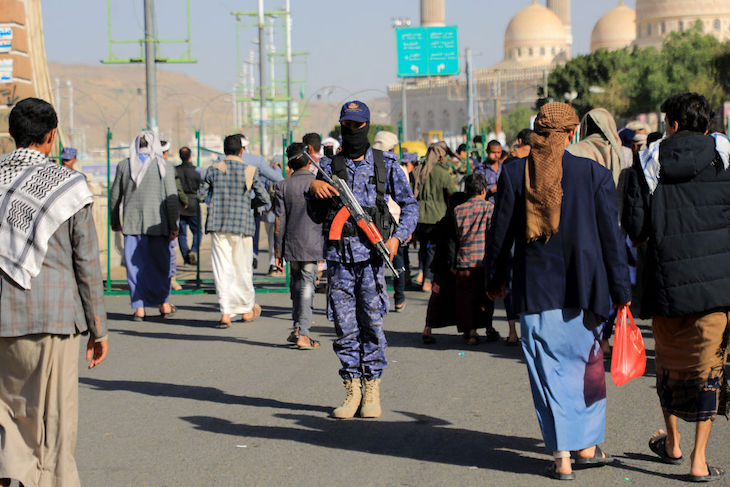Eventually then, enough was enough. After months of Houthi drone and missile attacks on Israel and vessels in the Red Sea, the US and the UK launched retaliatory strikes in Yemen last week. But how did we get here?
The Houthis have been a nuisance for at least 30 years, when they emerged as a clan-based opposition movement in the northernmost governorate of Yemen. They had a number of grievances: endemic poverty, government hostility and Saudi-funded attempts to spread Salafism in their Zaidi Shia stronghold. The last Zaidi ruler had been deposed in 1962. The subsequent civil war set the stage for more or less continuous domestic turmoil ever since. The 1990 shotgun marriage between North and South exacerbated the conflict. Southern Yemen and the Hadhramaut – the ancestral home of Osama bin Laden – became a fertile recruiting ground for violent Sunni Islamists. At the same time, president Ali Abdullah Saleh, who famously described governing Yemen as like ‘dancing on the heads of snakes’, alienated virtually all his neighbours with his Baldrick-like lack of cunning.
The Houthis have been a nuisance for at least 30 years
During the so-called Arab Spring, these discontents exploded. Saleh was assassinated, Saudi Arabia launched a military intervention, and the Houthis, who have fought and won border conflicts with Riyadh since 2004, have emerged strengthened, though at the cost of around 350,000 deaths and massive economic damage.
Iran claimed the Houthis, in spite of some doctrinal differences, as fellow Shia. The Houthis reciprocated. This gave Tehran an opportunity on the cheap to make mischief for its great Sunni rival, Saudi Arabia, and to gain a hold on the Bab al Mandab strait, one of the Middle East’s three economic choke-points. The Iranians could already restrict access to the Gulf through the first chokepoint, the Straits of Hormuz. The Bab al Mandab strait controls maritime transit between the Red Sea and the Indian Ocean. The third chokepoint, the Suez Canal, was vulnerable to any disruption in the Red Sea. By successfully promoting their influence in Yemen, as they had after 2003 in Iraq, they could threaten all the major maritime trade routes in the region, an extraordinarily valuable asset for a regime which has always sought to fight its battles deniably, away from the heartland and on terms deeply unfavourable to its enemies.
Recent Houthi attacks on container ships transiting the Bab al Mandab have caused shipping costs to spiral. They have led to a spike in maritime insurance rates and an uptick in oil prices. They threaten Egypt’s revenues from the Suez Canal. They are a headache for Red Sea littoral states, such as Egypt, Jordan, Sudan and Saudi Arabia, which depend on imports for essential goods.
The Houthis say their aim is to pressure Israel and the US into ending the war in Gaza. But their targets are not just Israeli-affiliated ships. All major container companies have become reluctant to send cargo through the Bab al Mandab. That is not simply a little local difficulty. It is global, including for China, which has spent months gleefully blaming the US and its western allies for everything wrong with the contemporary Middle East.
And that’s the reason for the missile strikes. The US have sought to construct a multilateral maritime coalition to address the challenge. Other states – including Saudi Arabia and the UAE – have been reluctant to join. Britain, demonstrating despite Joe Biden’s prejudices that the US has no more reliable partner, has not. Missiles on their own will not be enough. The failure of the Saudi air campaign since 2015 has shown that the Houthis have extraordinary resilience and have enormous stocks of sophisticated Iranian weaponry. One answer may need to be a convoy system of some sort. In the longer term, an answer may be to develop alternative routes for trade and the renewed pursuit of a peace settlement in Yemen itself. But there is also the question of Gaza, the main excuse for the recent crisis.
Lebanon is likely to be the next theatre for a destructive conflict
There is also Lebanon, likely the next theatre for a destructive conflict, with Iran again pulling the strings. That’s one hell of an agenda for a US Administration which has set its heart on getting out of the Middle East. It’s a wake-up call for the UK, whose armed forces have been hollowed out by years of austerity among other factors. It’s a challenge for the states of the region whose economies will suffer if trade is hit. It’s hard to see a future for Red Sea tourism, and especially futuristic plans to ‘redefine liveability’ in the desert, if Iran continues to expand its malign influence across the region unchallenged.
In the few months left before the US election campaign begins in earnest, can the Biden Administration turn things around? Can the UK sustain its efforts to support the US when Ukraine is putting demands on our military infrastructure that we are finding it hard to sustain? Can Saudi Arabia, Egypt, the UAE and Jordan find enough common cause to help, if only in their own interests?
It’s a huge ask. But it’s hard to see any alternative. These challenges are not going away. I hope whichever party wins the General Election is ready for them.






Comments